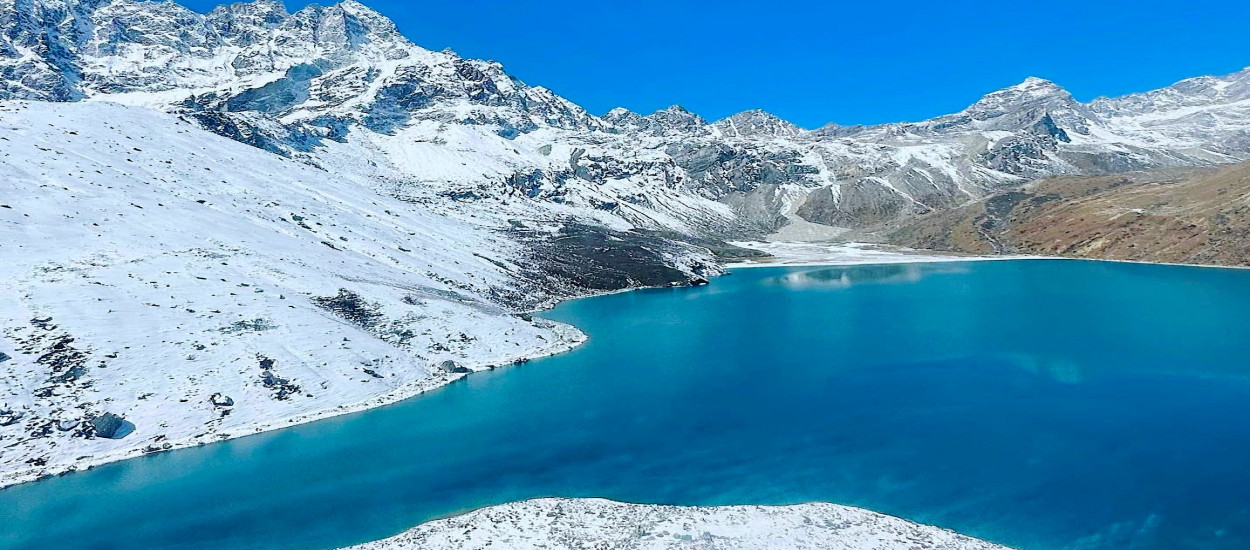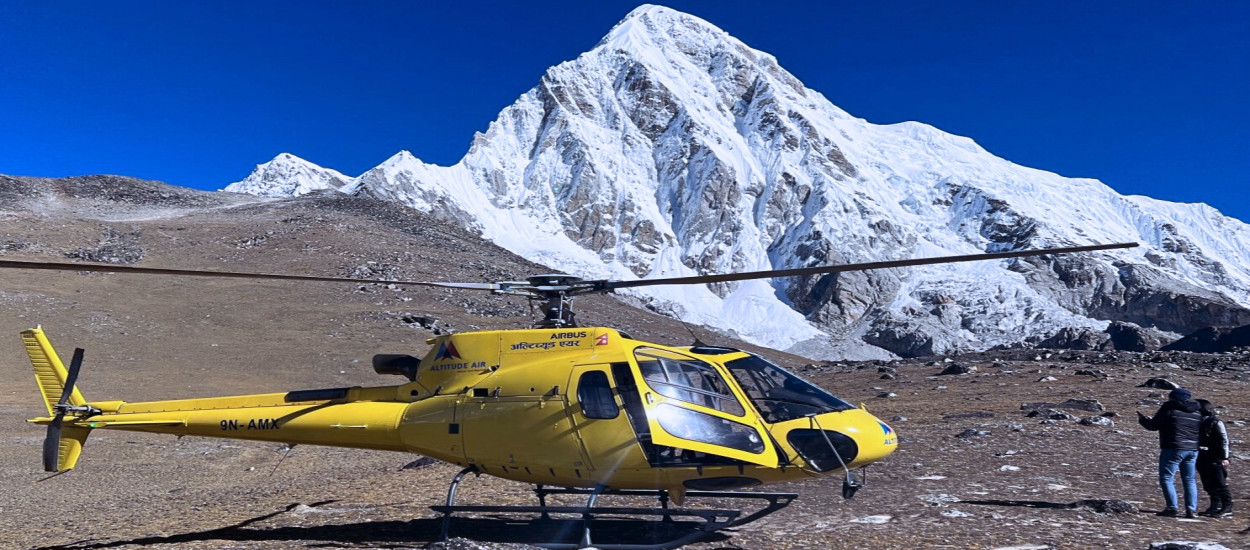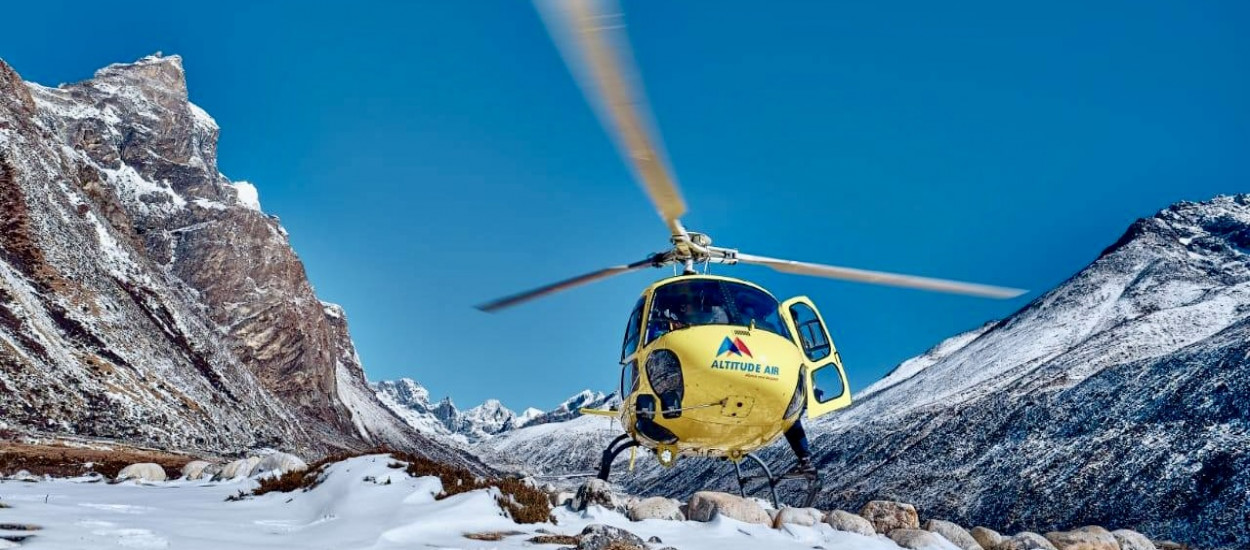Good to Know
Altitude during the Everest Base Camp Helicopter tour with landing from Kathmandu
Everest Base Camp Helicopter Tour with landing from Kathmandu, participants reach significant altitudes that offer breathtaking views of the Everest region. The journey begins at Kathmandu Airport, located at about 1,400 meters (4,593 feet) above sea level. From there, the helicopter ascends towards the Himalayas, ultimately reaching key destinations with notable altitudes:
-
Everest Base Camp: The helicopter lands at Everest Base Camp itself or nearby, depending on weather conditions. Everest Base Camp is situated at an altitude of approximately 5,364 meters (17,598 feet), offering a close-up view of the formidable Khumbu Icefall and the base where climbers gather for their summit attempts.
-
Kalapattar: Often included as a landing spot for the best views of Mount Everest, Kalapattar sits at an altitude of about 5,545 meters (18,192 feet). This location provides a spectacular vantage point for viewing Everest and the surrounding peaks, and is a highlight for many on this tour.
-
Everest View Hotel: While not a landing point on every tour, if included, this site offers a chance for refreshments at an altitude of 3,880 meters (12,730 feet). The hotel boasts panoramic views of the Everest range, providing a stunning backdrop for a brief stop.
While the high altitudes of the Everest Base Camp Helicopter Tour present potential health challenges, such as altitude sickness, proper preparation allows for a safe and remarkable adventure. This tour offers an unparalleled chance to experience the Himalayas' grandeur, making it a once-in-a-lifetime opportunity.
Permits for the Everest Base Camp Helicopter tour with landing from Kathmandu
To undertake the Everest Base Camp Helicopter Tour with landing from Kathmandu, certain permits are required due to the tour's entry into the protected areas of the Sagarmatha National Park, home to the world-famous Mount Everest. Here are the essential permits needed for this adventurous journey:
-
Sagarmatha National Park Permit: This is mandatory for anyone entering the area. The permit helps in the conservation efforts of the park and contributes to maintaining the natural environment. It ensures that the park remains pristine and beautiful for future generations.
-
TIMS Card (Trekkers' Information Management System): Although primarily used for trekkers, those on helicopter tours may also require a TIMS card, depending on the specific itinerary and whether any trekking is involved at or near the landing sites.
-
Local Area Permit: This is required for certain regions within the national park, especially if the helicopter tour includes stops at specific localities within the Everest region.
Obtaining necessary permits is essential for both legal compliance and environmental preservation within the Everest region. These permits support sustainable tourism practices and responsible management of visitor activities. When booking an Everest helicopter tour, ensure your operator, like Relax Getaways, handles all permit requirements. This ensures a seamless and legal experience, while also contributing to the protection of the fragile Himalayan ecosystem for future generations of travelers.
Preparation for the Everest Base Camp Helicopter tour with landing from Kathmandu
Preparing for the Everest Base Camp Helicopter Tour with landing from Kathmandu is essential to ensure a safe and enjoyable experience. This tour involves high altitudes and potentially rapid weather changes, making preparation key. Here’s how you can get ready for this adventure:
-
Health Check-up: Before booking the tour, consider a medical check-up to ensure you're fit for high altitudes. Discuss with your doctor any concerns regarding altitude sickness and its prevention.
-
Acclimatization: Although you won’t be trekking, the sudden change in altitude as the helicopter ascends can affect some people. Spend a few days in Kathmandu or at similar altitudes to acclimatize your body if possible.
-
Appropriate Clothing: The temperature at Everest Base Camp can be quite cold, especially in the morning and late afternoon. Dress in layers that you can add or remove as needed. Include thermal wear, a warm jacket (preferably windproof and waterproof), gloves, a beanie, and UV protection sunglasses.
-
Hydration: Stay hydrated before and during your flight. The dry air at high altitudes can lead to dehydration, which exacerbates the symptoms of altitude sickness.
-
Camera and Batteries: With breathtaking views around every corner, you’ll want to capture as many photos as possible. Make sure your camera is fully charged, and consider bringing extra batteries as cold weather can drain battery life quickly.
-
Sunscreen and Lip Balm: At high altitudes, UV radiation is stronger, even on cloudy days. Apply a high SPF sunscreen and use lip balm to protect against the sun and wind.
-
Travel Insurance: Ensure your travel insurance covers helicopter tours and high-altitude activities. It's important to have coverage for medical evacuation and altitude sickness.
-
Understand the Itinerary: Familiarize yourself with the tour itinerary. Knowing the schedule, including each landing and take-off, helps manage expectations and prepare mentally for the journey.
-
Respect Local Norms: Be aware of and respect local customs and environmental guidelines. This respect helps ensure that the areas visited remain pristine and welcoming to future tourists.
By adequately preparing for the Everest Base Camp Helicopter Tour, you can enhance your enjoyment and ensure that your experience is as memorable and safe as possible.
Nepal Visa for the Everest Base Camp Helicopter tour with landing from Kathmandu
If you're planning the Everest Base Camp Helicopter Tour with landing from Kathmandu, securing a Nepal visa is an essential step in your travel preparations. Here's a comprehensive guide on how to obtain your visa for Nepal:
Visa on Arrival: Most travelers can obtain a visa on arrival at Tribhuvan International Airport in Kathmandu, Nepal’s main entry point. This process is straightforward, requiring a completed application form, a passport-sized photo, and the visa fee.
Visa Fees: The visa fee depends on the duration of your stay:
-
15 days – $30 USD
-
30 days – $50 USD
-
90 days – $125 USD
Required Documents: To apply for the visa, you will need:
-
A passport valid for at least six months beyond the date of entry.
-
One recent passport-size photograph.
-
Visa fee, payable in cash (credit cards are not always accepted at the visa counters).
Online Application: You can also apply for a visa online before departure. The online application can be found on the official website of the Department of Immigration, Nepal. This e-visa is recommended to save time that would otherwise be spent in queues at the airport. The online application should be completed at least 15 days before your travel date.
Extendable Visas: If you find yourself wanting to extend your stay for more exploration or unforeseen circumstances, you can extend your visa up to 150 days per calendar year from the date of entry. Visa extensions can be obtained from the Department of Immigration in Kathmandu.
Other Entry Points: If you're entering Nepal via land, there are several border crossings where visas on arrival are available, including Kakarbhitta, Birgunj, Bhairahawa, Nepalgunj, Dhangadhi, and Mahendranagar.
By securing your Nepal visa efficiently, you ensure that your entry into Nepal is smooth, allowing you more time to enjoy the breathtaking experiences awaiting you on your Everest Base Camp Helicopter Tour. Make sure to check the latest visa rules and requirements before your trip as regulations can change.
Safety on the Everest Base Camp Helicopter tour with landing from Kathmandu
Safety is a paramount concern for anyone embarking on the Everest Base Camp Helicopter Tour with landing from Kathmandu. Given the unique challenges posed by high-altitude flying, it's essential to consider all aspects of safety to ensure a secure and enjoyable experience. Here are key safety measures and considerations for this helicopter tour:
-
Experienced Pilots: One of the most critical factors is the expertise of the pilots. Ensure your tour is conducted by highly trained and experienced pilots familiar with the Everest region's terrain and specific flying conditions. Pilots trained in high-altitude flying bring a significant safety advantage.
-
Helicopter Maintenance: The helicopter used for your tour should be well-maintained and suitable for high-altitude operations. Regular checks and maintenance are crucial, especially given the demanding conditions of the Himalayan environment.
-
Weather Dependence: Weather in the Everest region can change rapidly. Tours are heavily dependent on favorable weather conditions. Operators typically have strict guidelines about flying only when the weather permits, and flights may be delayed or rescheduled based on real-time conditions to ensure safety.
-
Altitude Sickness Awareness: Altitude sickness is a serious concern in high-altitude areas. Be aware of the symptoms, which can include headache, nausea, and dizziness. Tour operators should provide safety briefings on how to recognize and address altitude sickness and carry oxygen on board in case of emergencies.
-
Safety Briefings: Before the flight, a comprehensive safety briefing should be provided to all passengers. This includes instructions on how to use safety equipment, what to do in an emergency, and specific guidelines for boarding and disembarking the helicopter.
-
Emergency Procedures: Ensure that the helicopter company has clear and tested emergency procedures. This includes having communication systems in place to contact rescue services if necessary.
-
Insurance: It is advisable to have travel insurance that covers helicopter tours and high-altitude medical evacuation. This adds an extra layer of security for dealing with unforeseen situations.
-
Environmental Considerations: Flying at high altitudes can impact the environment. Responsible tour operators should follow practices that minimize ecological impact, such as adhering to designated flight paths and landing zones.
By ensuring these safety measures are in place, passengers can feel secure knowing that their Everest Base Camp Helicopter Tour prioritizes their well-being while offering an extraordinary adventure in one of the world's most stunning settings.
Trip Extensions on the Everest Base Camp Helicopter tour with landing from Kathmandu
If you're planning the Everest Base Camp Helicopter Tour with landing from Kathmandu, there are several exciting trip extensions that can enhance your experience and allow you to explore more of Nepal’s breathtaking landscapes and rich culture. Here are some popular options for trip extensions:
-
Cultural Tours in Kathmandu Valley: After your Everest Base Camp Helicopter Tour, extend your stay to explore the historic and cultural treasures of Kathmandu Valley. Visit UNESCO World Heritage sites like Pashupatinath Temple, Boudhanath Stupa, and the ancient cities of Bhaktapur and Patan, where traditional architecture and local art thrive.
-
Pokhara and Annapurna Region: For those looking for more adventure, a visit to Pokhara, Nepal’s adventure capital, is a great trip extension. Here, you can enjoy boating on Phewa Lake, paragliding with views of the Annapurna range, or even embark on a short trek to nearby villages like Ghandruk.
-
Chitwan National Park Safari: If you're interested in wildlife, a trip to Chitwan National Park offers an incredible opportunity to spot rhinos, tigers, elephants, and other wildlife in their natural habitat. This jungle safari can be a refreshing change from the high-altitude Everest region.
-
Lumbini - Birthplace of Buddha: For a peaceful and spiritual journey, extend your trip to Lumbini, the birthplace of Lord Buddha. This UNESCO World Heritage site is home to beautiful monasteries, the sacred Mayadevi Temple, and the Ashoka Pillar.
-
Trekking Extensions: For those interested in trekking, you can opt for short treks such as the Ghorepani Poon Hill Trek or the Langtang Valley Trek. These treks offer breathtaking views of the Himalayas and immerse you in the culture of Nepal’s mountain villages.
-
Helicopter Tours to Annapurna Base Camp: If you want to continue exploring the Himalayas by air, consider a Helicopter Tour to Annapurna Base Camp. This extension offers equally stunning views of another iconic Himalayan region and is a perfect complement to your Everest Base Camp Helicopter Tour.
By adding one of these trip extensions to your Everest Base Camp Helicopter Tour, you can make the most of your time in Nepal, exploring its diverse landscapes, cultural richness, and adventure opportunities. Each extension provides a unique experience that showcases different aspects of Nepal, from its wildlife and spirituality to its trekking and adventure hotspots.
Tipping for the Everest Base Camp Helicopter tour with landing from Kathmandu
Tipping is a common practice in Nepal and is often appreciated by those who provide services during your Everest Base Camp Helicopter Tour with landing from Kathmandu. While tipping is not mandatory, it is a way to show appreciation for excellent service. Here’s a guide to help you understand tipping etiquette during the tour:
-
Pilots: If you feel that your pilot has provided a smooth and enjoyable flight, a tip is a great way to express your gratitude. A typical tip for helicopter pilots can range from $20 to $50 USD per passenger, depending on the level of service and your satisfaction.
-
Ground Staff and Guides: Any guides or ground crew assisting you during the Everest Base Camp Helicopter Tour may also appreciate a tip. For these staff members, a tip between $10 to $20 USD is generally considered appropriate. They play a crucial role in ensuring a seamless experience, from check-in to briefing and safety.
-
Hotel and Transportation Staff: If your tour includes airport transfers or hotel stays, tipping the drivers or hotel staff is also a good practice. Typically, $5 to $10 USD for drivers or hotel porters is appreciated for good service.
-
When and How to Tip: Tipping is usually done in cash, so it’s a good idea to carry small denominations of Nepalese Rupees or USD with you. Tipping can be done at the end of the service, such as after the helicopter tour or when being dropped off at your hotel.
-
Cultural Sensitivity: Tipping in Nepal is not as formalized as in some other countries. While it is appreciated, always offer it with discretion and respect. Nepalese culture values humility, and tips should be given as a gesture of appreciation rather than expectation.
While tipping for the Everest Base Camp Helicopter Tour is not obligatory, it is a generous and much-appreciated gesture to reward exceptional service from pilots, guides, and other staff who contribute to making your experience memorable.
For instant Booking confirmation and Booking Calender



